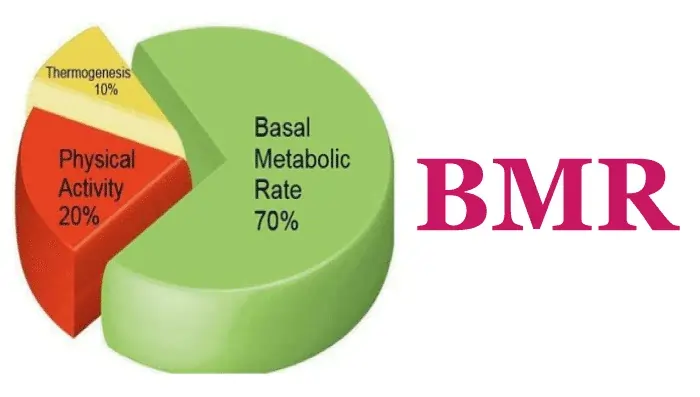Basal Metabolic Rate (BMR)
Basal Metabolic Rate (BMR) is the amount of energy (calories) your body needs to function at rest. It accounts for about 60-75% of the total calories you burn each day.
BMR represents the minimum energy expenditure needed to sustain life and accounts for about 60-75% of your daily calorie needs.
Understanding BMR is crucial for managing weight, designing fitness routines, and developing tailored nutrition plans. Factors influencing BMR include age, gender, body composition, and genetics, making it a personalized measure of metabolic activity.
What is it?
A person’s basal metabolic rate (BMR) calculates how many calories they must burn in 24 hours of rest to maintain their essential bodily processes. These functions include, for instance:
- breathing,
- circulation,
- nutrient digestion and absorption, and cellular functions
What is meant by BMR?
The energy (calories) your body requires to carry out essential processes including respiration, circulation of blood, the development of cells, body temperature regulation, hair growth, and hormone production is known as your basal metabolic rate, or BMR.
Activity levels and BMR are sometimes misunderstood, but BMR only relates to vital body processes. To put it another way, BMR only accounts for your body’s resting activity.
One component of metabolism is the basal metabolic rate, which is the process by which food—liquid or solid—is transformed into energy. Food and oxygen combine at each meal to produce energy. Even though you only eat three times a day, your body’s metabolic processes are ongoing.
Calories burned during daily activity and exercise are also included in your metabolism, in addition to your BMR. These elements work together to determine how much energy you use overall. Here is a quick synopsis:
Resting calories: Your basal metabolic rate accounts for between 70 and 80 percent of the calories you burn. The body can burn roughly fifty calories each hour while you sleep.
Food’s thermal effect: Food digestion requires energy. Breaking down and storing the food you eat accounts for about 10% of your daily caloric expenditure.
Calories expended while not exercising are included in the activity calories. Nonexercise activity thermogenesis (NEAT) is another name for it, and it encompasses anything from strolling to the kitchen to prepare lunch to brushing your teeth. Depending on your daily activities, your caloric expenditure can range from 100 to 800.
Exercise calories: These are the calories burned during physical activity, such as walking, bicycling, running, or strength training, as the name implies.
RMR vs BMR:
Basal metabolic rate and resting metabolic rate are sometimes confused. Although they are comparable, RMR (also known as resting energy expenditure) is the actual quantity of calories burned while at rest, whereas BMR describes the calories required to perform essential processes at rest. Low-energy activities like making a sandwich for lunch or using the restroom are included in RMR.
After 15 minutes of sitting or lying down without exercising that day, your oxygen intake and carbon dioxide output are analyzed to determine your RMR.
Since RMR takes into consideration both performing essential biological functions and low-effort activities, your BMR will typically be lower than your RMR. Your body’s daily calorie requirements for basic processes can be determined using your BMR. On the other hand, RMR is a more accurate way to measure your daily caloric expenditure when you don’t exercise.
What affects BMR?
The BMR of each individual is determined by several factors, some of which are under your control (e.g., body composition) and others of which are beyond your control (e.g., age, gender, hormones).
- Age: There is an inverse relationship between BMR and age; toddlers have a higher BMR than elderly adults. Generally speaking, muscular mass decreases with age. Consequently, BMR falls.
- Body composition: People with more muscle mass and a lower percentage of body fat have higher BMRs because muscle requires more energy than fat (fatty tissue doesn’t).
- Body shape: A person’s BMR is higher if their body surface is larger (tall and skinny). A person’s BMR is lower if they are shorter and heavier.
- Gender: Due to their larger height and greater muscle mass, men frequently have higher BMRs than women.
- Hormones: The thyroid produces the hormone thyroxine, which regulates how much energy your body consumes. increased thyroxine levels are associated with increased BMR.
How can BMR assist?
Although the number of calories your body requires when it is sedentary may not seem like much, BMR is useful for a variety of reasons.
First of all, whether or not you’re dieting, it helps you understand your calorie demands and goals. Knowing your BMR gives you a foundation of how many calories your body requires to carry out essential processes. A BMR of 1,500, for instance, indicates that you must eat at least 1,500 calories per day to support your body’s optimal operation. If you intend to gain, reduce, or stay the same weight, this information is crucial.
BMR serves as a starting point for determining how many calories you must consume and burn to lose weight if you intend to follow a diet. If your BMR is 1,700, for example, and you burn an additional 300 calories doing low-energy tasks and then go for a run that burns an additional 250 calories, You ought to be aware that your daily break-even calorie intake is 2,250. You can lose weight by eating anything under 2,250 calories. This is known as a negative energy balance, which is the difference between the energy you burn (calories out) and the energy you take in (calories in).
Lastly, BMR can be used to monitor muscular growth and strength. As muscle mass grows and adipose tissue shrinks, BMR may rise.
What makes a BMR good?
Everybody has a different BMR, thus they shouldn’t be compared. As a result, neither a good nor a bad BMR exists. The BMRs of individuals who are identical in terms of age, sex, height, weight, and body composition might differ by up to 10%. These variations are explained by elements like heredity or even organ size; some persons have huge organs that need more energy to operate.
Your BMR is usually between 1,000 and 2,000, which means that your body needs 1,000 to 2,000 calories to power its essential processes. While men’s BMR typically ranges from 1,600 to 1,800, women’s BMR typically hovers around 1,400.
Calculator for BMR
Your BMR can be determined using one of two types of equations: the Harris-Benedict equation or the Mifflin St. Jeor equation.
A more recent and precise method, the Mifflin St. Jeor, likewise adds your height and weight, then subtracts it by your age plus a predetermined amount, which is 5 for men and 161 for women.
In 1919, the Harris-Benedict equation was developed. This formula adds your height and weight and subtracts your age from a predetermined amount, which is 655.1 for women and 66.47 for men.
Here is an illustration that makes use of both formulas: The BMR of a 20-year-old man who is 6 feet tall and 180 pounds would be:
BMR = (10 x 81.6466 = 816.466) + (6.25 x 182.88 = 1,143) – (20 x 5 = 100) + 5 = 1,864.466 is the value of Miffin St. Jeor.
The BMR of Harris Benedict is 66.47 + (13.75 × 81.6466 = 1,122.64) + (5.003 × 182.88 = 914.95) – (6.755 × 20 = 135.1) = 1,968.96.
As you can see, you get 1,864 total calories from the Mifflin St. Jeor equation. This indicates that if you spend the entire day in bed, your body will burn 1,864 calories.
When age is taken into account, an 80-year-old guy with the same height and weight will have a BMR of 1,564. Since they don’t require as many calories each day, many elderly people eat less, which can be explained by the 300-calorie difference.
Methods for calculating your BMR:
Weight, height, age, and sex are all factors in the Harris-Benedict formula, which is a widely used method for estimating trusted Source BMR.
FAABs, or females assigned at birth
BMR is equal to 655 + 9.6 x kg body weight + 1.8 x cm height – (4.7 x years of age).
Males assigned (MAABs) at birth
66 + (13.7 x kg of weight) + (5 x cm of height) – (6.8 x years of age)
What makes BMR significant?
RMR and BMR both show how many calories a person burns while at rest. A person attempting to control their weight could find this information useful.
Finding their BMR or RMR could help someone who is trying to lose weight determine how many calories they should consume each day. In certain situations, this can include taking just enough calories to sustain vital bodily processes.
Alternatively, if someone wishes to put on weight, they can figure out how many extra calories they need to eat each day by using their BMR or RMR formula.
Methods for altering the basal metabolic rate:
A person’s BMR and RMR are determined by several factors. The only two of these variables that an individual may be able to alter are their weight and body composition.
Therefore, reducing weight from fat and increasing lean muscle mass can change a person’s BMR and RMR.
Following to do this:
- consuming a balanced diet
- engaging in regular cardiovascular exercise and resistance training
Summary
BMR calculates how many calories a person requires to maintain their essential bodily processes while at rest. Only in a carefully monitored clinical environment can an individual obtain an accurate BMR estimation.
A person’s resting caloric expenditure is also estimated by RMR. Compared to BMR, RMR estimation has fewer stringent testing criteria.
For those attempting to control their weight, both BMR and RMR estimates may be useful. They can show how many calories a person needs to consume each day to reach their desired weight.
A decent estimate of RMR can be obtained using equations and internet calculators. However, if they want more precise results, they should see their healthcare physician.
FAQs
What BMR rate is considered normal?
Your BMR is usually between 1,000 and 2,000, which means that your body needs 1,000 to 2,000 calories to power its essential processes. While men’s BMR typically ranges from 1,600 to 1,800, women’s BMR typically hovers around 1,400.
BMR basal rate: what is it?
BMR Definition: The quantity of calories you burn while your body carries out essential life-sustaining functions is known as your basal metabolic rate or BMR. Resting Metabolic Rate (RMR), which is the number of calories burned if you are in bed all day, is another common name for it.
What is the calorie burn from 10,000 steps?
At an average pace of 3 mph, you burn about 469 kcal while walking 10,000 steps. You will burn about 559 kcal and take a lot longer if you go at a pace of 2 mph. You will burn about 501 kcal if you walk quickly—4 mph.
A decent basal rate is what?
Your blood glucose should not fluctuate by more than 1.7 mmol/L over or below your initial blood glucose level during the basal rate test. For instance, the permissible range for the test would be 5.3 to 8.7 mmol/L if your initial blood glucose level was 7.0 mmol/L.
How can my BMR be tested?
BMR and RMR may be measured most accurately in a lab setting. This is accomplished by breathing into a calorimeter, a mask that measures your resting caloric expenditure by calculating your breathing rate.
References
- Frothingham, S. (2023, May 5). What Is Basal Metabolic Rate? Healthline. https://www.healthline.com/health/what-is-basal-metabolic-rate#takeaway
- Fletcher, J. (2020, March 9). What to know about basal metabolic rate. https://www.medicalnewstoday.com/articles/basal-metabolic-rate#summary




7 Comments